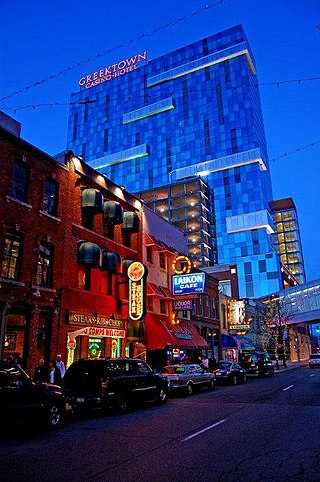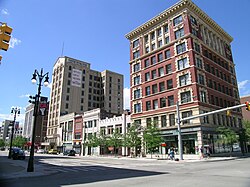
Corktown is a neighborhood located in Detroit, Michigan. It is the oldest extant neighborhood in the city. The current boundaries of the district include I-75 to the north, the Lodge Freeway to the east, Bagley and Porter streets to the south, and Rosa Parks Boulevard to the west. The neighborhood was listed on the National Register of Historic Places in 1978.

Greektown is a commercial and entertainment district in Detroit, Michigan, located just northeast of the heart of downtown, along Monroe Avenue between Brush and St. Antoine streets. It has a station by that name on the city's elevated downtown transit system known as the Detroit People Mover. Greektown is situated between the Renaissance Center, Comerica Park, and Ford Field.

The Grand Circus Park Historic District contains the 5-acre (2.0 ha) Grand Circus Park in Downtown Detroit, Michigan that connects the theatre district with its financial district. It is bisected by Woodward Avenue, four blocks north of Campus Martius Park, and is roughly bounded by Clifford, John R. and Adams Streets. The district was listed on the National Register of Historic Places in 1983. The building at 25 West Elizabeth Street was added to the district in 2000, and additional structures located within the district, but built between 1932 and 1960, were approved for inclusion in 2012.
The culture of Detroit, Michigan, has influenced American and global culture through its commercial enterprises and various forms of popular music throughout the 20th and 21st century. Its automotive heritage plays an important role in the city's culture.

The Merchants Building is a commercial building located at 206 East Grand River Avenue in Downtown Detroit. It is also known as the Broadway Merchants Building. It was listed on the National Register of Historic Places in 1983.

Downtown Paterson is the main commercial district of Paterson, Passaic County, in the U.S. state of New Jersey. The area is the oldest part of the city, along the banks of the Passaic River and its Great Falls. It is roughly bounded by Interstate 80, Garret Mountain Reservation, Route 19, Oliver Street, and Spruce Street on the south; the Passaic River, West Broadway, Cliff Street, North 3rd Street, Haledon Avenue, and the borough of Prospect Park on the west; and the Passaic River also to the north.

The architecture of metropolitan Detroit continues to attract the attention of architects and preservationists alike. With one of the world's recognizable skylines, Detroit's waterfront panorama shows a variety of architectural styles. The post-modern neogothic spires of One Detroit Center refer to designs of the city's historic Art Deco skyscrapers. Together with the Renaissance Center, they form the city's distinctive skyline.

The Religious Structures of Woodward Avenue Thematic Resource (TR) is a multiple property submission to the National Register of Historic Places which was approved on August 3, 1982. The structures are located on Woodward Avenue in the cities of Detroit and Highland Park, Michigan.

This is a list of the National Register of Historic Places listings in Detroit, Michigan.

The Warren–Prentis Historic District is a historic district in Detroit, Michigan, including the east–west streets of Prentis, Forest, Hancock, and the south side of Warren, running from Woodward Avenue on the east to Third Avenue on the west. The district was listed on the National Register of Historic Places in 1997.

The Monroe Avenue Commercial Buildings, also known as the Monroe Block, is a historic district located along a block-and-a-half stretch at 16-118 Monroe Avenue in Detroit, Michigan, just off Woodward Avenue at the northern end of Campus Martius. The district was designated a Michigan State Historic Site in 1974 and listed on the National Register of Historic Places in 1975. The thirteen original buildings were built between 1852 and 1911 and ranged from two to five stories in height. The National Theatre, built in 1911, is the oldest surviving theatre in Detroit, a part of the city's original theatre district of the late 19th century, and the sole surviving structure from the original Monroe Avenue Commercial Buildings historic period.

The Harmonie Club is a club located at 267 East Grand River Avenue in Downtown Detroit, Michigan. It was designated a Michigan State Historic Site in 1975 and listed on the National Register of Historic Places in 1980.

The Randolph Street Commercial Buildings Historic District is a historic district located in Downtown Detroit, Michigan, which includes six buildings along Randolph Street between Monroe and Macomb streets. The district was listed on the National Register of Historic Places in 1980. The collection of buildings are a rare surviving set of Detroit Victorian-era commercial structures. The Randolph Street Commercial Building Historic District joins the Broadway Avenue Historic District downtown.

The Cary Building is a commercial building located at 229 Gratiot Avenue in Downtown Detroit. It was listed on the National Register of Historic Places in 1983.

The Harmonie Centre, also known as the Breitmeyer–Tobin Building, is an eight-story commercial building located at 1308 Broadway Street in Downtown Detroit. It is part of the Broadway Avenue Historic District. It is also known as the Tobin Building. The building was listed on the National Register of Historic Places in 1980. The east necklace of downtown links Grand Circus and the stadium area to Greektown along Broadway. The east necklace contains a sub-district sometimes called the Harmonie Park District, which has taken on the renowned legacy of Detroit's music from the 1930s through the 1950s and into the present.
The performing arts in Detroit include orchestra, live music, and theater, with more than a dozen performing arts venues. The stages and old time film palaces are generally located along Woodward Avenue, the city's central thoroughfare, in the Downtown, Midtown, and New Center areas. Some additional venues are located in neighborhood areas of the city. Many of the city's significant historic theaters have been revitalized.

This is a list of the National Register of Historic Places listings in Downtown and Midtown Detroit, Michigan. It is intended to be a complete list of the properties and districts on the National Register of Historic Places in Downtown and Midtown neighborhoods in Detroit, Michigan, United States. Latitude and longitude coordinates are provided for many National Register properties and districts; these locations may be seen together in online maps.

The Williamston Downtown Historic District is a commercial historic district consisting of the first blocks of East and West Grand River Avenue, and the first block of South Putnam Street in Williamston, Michigan. The district was listed on the National Register of Historic Places in 2012.

Joseph E. Mills was an architect based in Detroit, Michigan. He designed the Muscatine County Courthouse in Muscatine County, Michigan, which is listed on the National Register of Historic Places. He also worked on buildings in Ionia, Michigan and on the Harrison County Courthouse in Logan, Iowa, county seat of Harrison County, Iowa.





















